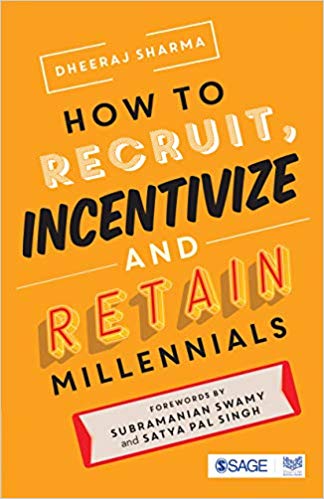Millennials are a unique generation. It is important to understand what drives this group, since this has important implications for modern workplaces. Yes, millennials in the workplace have changed the game completely. Old rules don’t apply anymore. How do millennials approach their lives and how do they approach work? Who are the different types of millennials? What are the common misconceptions that we have about them? And most importantly, how does an employer recruit and retain millennials?
How to Recruit, Incentivize and Retain Millennials
Now wouldn’t it be nice to have a guide, an easily understandable guide, on how to employ, retain and incentive millennials in the workplace? How to Recruit, Incentivize and Retain Millennials by Dheeraj Sharma (Sage Publications) is your go-to guide, to put it very simply. The book is based on thorough research and analysis. This gives an authentic base to what Dr. Sharma lists out in the book. However, despite the very academic roots of the book, it has been written in really simple language. Hence, managers, business owners, recruiters and other professionals who deal with millennials will find it very easy to read and follow.
I also appreciate the way Dr. Sharma has given a literary twist to an academic subject. For example, in a chapter that discusses why millennials are the way they are, he talks about the impact of “helicopter parenting” on millennials. Interestingly, he quotes an example from the Mahabharata, on how such a parenting style impacted Duryodhana! Such links and connections give an interesting angle to the book. The language is simple and the book is packed with information that can be easily and immediately applied. I also love the fact that there are several tables that present key points in an easy to understand manner.
The Indian context
Yes, the world is flat and boundaries between nations are thinning. But, the truth is that local events affect a cohort of people. This is a book that specifically talks about Indian millennials. The context, social and political, that these millennials have is tied to India as a country and India as a geography and culture. This specificity makes the books quite relevant to Indian workplaces. The book also discusses international events that have impacted this group, but the context remains rooted in India.
What to expect…
So, what can you as a reader expect from this book? Firstly, you will understand the qualities that make a millennial different from other generations such as the Baby boomers and Gen X. This is not to say that the book pigeonholes the millennials. Not at all. You will also understand how there are so many differences within the millennials themselves. Yet, there are stings of characteristics that make up this cohort, and you will understand what they are.
The reader also gets a peek into why millennials are the way they are, and how companies can actually leverage this knowledge to acquire and retain millennials in the workplace. There are also helpful tips on recruiting millennials in the workplace. In fact, due to their prowess with technology, the very manner of recruiting has changed thanks to the millennials. Companies first have to start with the fact that millennials are involved in technologically advanced ways of job search. This has implications for the website design, the application process, the job recruitment advertisements and so on. One of the crucial game changers here is the gig economy, which millennials increasingly seem to gravitate towards. How can companies leverage this? The book comprehensively chronicles these nitty-gritties which are all very relevant to the recruitment process.
Case Studies…
The book is laden with case studies and real-life examples. Nothing better than seeing a research idea or finding applied in practice, right? Right from new companies like Netflix to the good old ones like Infosys, how have they negotiated this terrain of millennials in the workplace? Interwoven between the many points and arguments that he makes, Dr. Sharma has also included examples from new age start-ups like Oyo Rooms and a host of online ventures and family owned businesses in India.
Millennials versus the rest
Now for the crux of the matter. Having understood millennials in the workplace…..what is important is to understand how they actually relate to the “other” generations working in the same office. A millennial may be completely dependent on technology for most of the tasks he does. A person from the Gen X, may be well-versed with technology, but not necessarily use it in the same manner as a millennial. Further, the two generations have different views on ‘loyalty’ towards the firm, with the millennials more likely to indulge in job-hopping. How can a company balance and retain both these groups and avoid intergenerational conflicts? The book describes how IBM fostered a culture of mutual respect, and at the same time allowed for flexibility in work schedules (among other things) to address concerns of the different groups working in the company. The result was that attrition rate reduced drastically compared to other firms.

The book offers strategies to resolve generational tensions, a highly useful chapter in terms of practicalities. This continues in subsequent chapters as well, with some great pointers on different ways and strategies to manage intergenerational relationships within an organization in general, and more specifically, navigating the strategies of managing millennials in the workplace.
There are specific suggestions on how to use what we know about the characteristics of millennials in order to align them with the vision of the company, and ensure they are happy there. For example, one of the key features of a millennial taskforce is the desire to give time and energy to passions other than their job-tasks. Companies such as Google have used this and fostered the innovative spirit by offering time and resources for employees to work on innovative ideas aside from their main jobs. This in turn boosts their job engagement.
The Family Business and Millennials
Family businesses are an important part of the economy. The last chapter discusses the succession planning of millennials in family businesses. This is again a very relevant piece of information for Indian companies, which grapple with succession planning issues in face of changing times.
Who should use this book….and how
I think that this would be very insightful for HR Professionals and leaders or managers who work with the millennial workforce. Since the book is quite specific to India, it is a useful tool for Indian businesses as well as multinational businesses that are looking at working here. There are a multitude of references and research studies herein which makes it a good book for academic study, for management studies or students of industrial psychology.
Millennials in the workplace? How to Recruit, Incentivize and Retain Millennials by Dheeraj Sharma is a sound and research-based book filled with a lot of practical advice. Yes indeed, it’s your go-to guide for managing millennials in the workplace!
Other books about Millennials at the workplace




